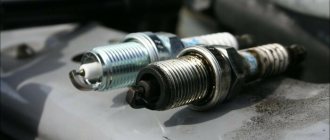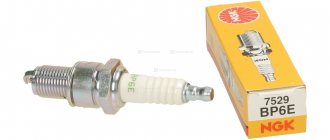When designing the small car VAZ Oka 1111 and 11113, many components and mechanisms were “borrowed” from other VAZ models, which made it possible to reduce the cost of car production and speed up the start of production. But the designers had to significantly rework some components in order to adapt them to the features of the Oka engine. One of these components is the ignition system.
When creating the ignition system, the designers used modern developments of those years. The VAZ Oka received a non-contact ignition system. At the same time, the features of the power plant made it possible to somewhat simplify the system and reduce the number of components, which had a positive impact on the reliability of this component of the power plant.
Design
The ignition system of the VAZ Oka consists of only seven main elements:
- Auxiliary relay;
- Egnition lock;
- Circuit breakers;
- Switch;
- Spark moment sensor;
- Coil;
- Candles;
All elements are connected to each other by wiring.
Using the ignition switch, the driver controls the power supply to the system from a source - the battery, while the voltage passes through the auxiliary relay and fuses. The lock has three positions - “0”, in which all electrical consumers are turned off, “1” - voltage is supplied to the ignition system and a number of other devices, and “2” - current is supplied to the starter. This switching sequence ensures that the ignition system is activated at the moment the engine starts.
Spark torque sensor
The spark timing sensor is one of the main ignition components, since it sets pulses that are subsequently converted into a spark discharge between the spark plug contacts. This sensor is driven by the camshaft, which allows you to accurately set the timing of the spark in the cylinders.
The main working elements of the unit are the Hall sensor and a special screen with slots mounted on the drive shaft interacting with the camshaft. The interaction of these elements leads to the emergence of control impulses.
The sensor not only sets pulses, it also “adjusts” to the operating conditions of the motor, adjusting the advance angle depending on the operating conditions of the motor (speed, load).
The adjustment is carried out by two regulators - vacuum and centrifugal, included in the design of the spark generation moment sensor.
Until 1989, Oka used a sensor of type 55.3706, and after that it was replaced by model 5520.3706.
Switch
The switch acts as a circuit breaker for the primary winding of the coil, using control pulses coming from the spark sensor. Circuit interruption in the switch is performed by the output transistor. The switch is completely electronic, without any moving elements, so the ignition system is contactless.
Several types of switches were installed on the VAZ-1111 and 11113 - 36.3734, 3620.3734, as well as HIM-52. The switch is installed in the engine compartment near the engine panel. It is secured with two bolts, so replacing the switch is quite simple.
Coil
Oka received a two-terminal ignition coil, which made it possible to remove the distributor from the design.
It is noteworthy that the high voltage in this coil is supplied simultaneously to both spark plugs. Moreover, due to the offset strokes in the engine cylinders, only one spark discharge is working, the spark on the second spark plug is the so-called “idle”.
The standard coil on the Oka is type 29.3705, but it has an analogue that is suitable for use on a small car - 3012.3705.
Wires, spark plugs
All wiring consists of low and high voltage wires. The first ones are used to connect all the components up to the coil. These are ordinary wires of small cross-section, which is quite sufficient, since the voltage in the circuit up to the coil is low.
High voltage wires are used to connect the coil terminals to the spark plugs. For ease of connection, lugs are installed at the ends of these wires.
Recommended for use on Oka are spark plugs of type A17DVR - with an extended thread and an interference suppression resistor, as well as their analogues.
Which spark plugs are best for Oka
Scheme of the contactless ignition system of the OKA VAZ-1111 - 1113 car : 1 - ignition switch relay; 2 — ignition switch; 3 - fuse block; 4 - switch; 5—sparking moment sensor; 6 — ignition coil; 7 - spark plugs.
The ignition system is contactless. Consists of a spark torque sensor, switch, ignition coil, spark plugs, ignition switch and high and low voltage wires. Spark timing sensor - type 5520.3706 (until 1989, a type 55.3706 sensor was installed) with built-in vacuum and centrifugal ignition timing regulators. It sets the moment of spark formation depending on its initial setting, the number of revolutions of the crankshaft and the load on the engine. Reading of control pulses is based on the Hall effect. There is one pulse for each revolution of the crankshaft (two for each revolution of the camshaft). The initial ignition timing angle for the VAZ-1111 engine is −1 ±1° BTDC, for the VAZ-11113 - 4±1° BTDC. The switch - type 3620.3734, or 36.3734, or HIM-52 opens the power circuit of the primary winding of the ignition coil, converting the control pulses of the sensor into current pulses in the ignition coil. The switch is checked with an oscilloscope using a special method; if a malfunction is suspected (interruptions in engine operation, shots in the muffler), replace it with a known good one. Do not disconnect the switch connector while the ignition is on - this may damage it (as well as other components of the ignition system). The ignition coil is two-terminal, dry, type 29.3705 - with an open magnetic circuit, or type 3012.3705 - with a closed magnetic circuit. Data for testing: resistance of the primary winding at 25°C - (0.5 + 0.05) Ohm, secondary - (11 ± 1.5) kOhm. The insulation resistance to ground is at least 50 MOhm. Spark plugs - type A17DVR, or A17DVRM, or their imported analogues (with noise suppression resistors with a resistance of 4-10 kOhm). The gap between the electrodes should be within 0.7-0.8 mm (checked with a round wire probe). High-voltage wires - type PVVP-8 with distributed resistance (2000±200) Ohm/m or PVPPV-40 with distributed resistance (2550±270) Ohm/m. Do not touch high-voltage wires while the engine is running - this may result in electrical injury. It is also prohibited to start the engine or allow it to operate with an open HIGH VOLTAGE circuit (crushed wires) - this can lead to insulation burnout and failure of the electronic components of the ignition system. Ignition switch - type 2108-3704005-40 or KZ813 with an anti-theft locking device, blocking against re-starting the starter without first turning off the ignition. When the key is turned to the “ignition” position, voltage is applied to the control input of an additional relay type 113.3747-10, which, in turn, supplies voltage to the ignition coil and switch. Thus, the contacts of the ignition switch are relieved.
How it all works
The principle of operation of the ignition system is as follows: after turning the key to position “1” el. Energy from the battery is supplied to the ignition system components through the lock, fuses and auxiliary relay. In this case, high voltage pulses are not generated, since the spark torque sensor is not yet operational.
After activating the starter, the timing drive begins to rotate the camshaft, and accordingly the sensor shaft - the Hall sensor begins to interact with the screen, due to which control pulses are created.
Arriving at the commutator, these pulses interrupt the power supply circuit of the coil winding. When the power circuit is broken, a high voltage pulse is induced in the coil, which is transmitted through high-voltage wires to the spark plug, which leads to the formation of a spark between its electrodes.
Malfunctions
The simplified design of the ignition system and the absence of moving components ensures high reliability and ease of maintenance.
There are not so many malfunctions in the Oka ignition system:
- Switch failure;
- Hall sensor malfunction;
- Coil failure;
- Breakage or breakdown of wires, oxidation of contacts;
- Spark plug malfunction;
- Violation of the ignition timing;
Since the ignition system is directly involved in the operation of the engine, any malfunction in it immediately affects the performance of the engine - interruptions occur, the unit does not develop power, popping noises appear, or the unit simply does not start.
Diagnosis of a malfunction is carried out by visual inspection of the wiring and its connections, as well as by sequentially replacing all components with known good ones. A check using measuring instruments allows you to more accurately determine the faulty element.
The search for the problematic element is carried out from the candles. That is, first the presence of a spark is checked on them, then the high-voltage wires are inspected, and then the performance of the coil, switch, and Hall sensor is diagnosed.
The components of the ignition system are non-repairable, so if they break down they must be replaced.
Setting the advance angle
Setting the ignition timing is the only operation that is performed in the ignition system.
A strobe light is used to set the angle correctly. The technology for performing the work is not complicated. The algorithm of actions is as follows:
- We connect the strobe to the power source and the tip of the spark plug of the 1st cylinder (according to the instructions for the device);
- Remove the plug from the inspection window on the clutch housing;
- We start the engine (it should be idling);
- We direct the beam of light from the strobe into the viewing window;
- We determine the position of the marks (with the angle correctly set, the mark on the flywheel at the moment the strobe light beam flashes should be located between the central and rear marks on the crankcase);
- If the marks are not positioned correctly, make adjustments. To do this, loosen the bolts securing the spark moment sensor and rotating it around its axis until the marks match;
After adjustment, tighten the sensor fasteners, turn off the engine, disconnect the strobe light and replace the plug.
Spark plugs oka 11113
Typical breakdowns of the VAZ-1111
In general, the Oka car is a fairly reliable and unpretentious model: the car has low fuel consumption, a high-quality chassis that is perfectly adapted to our roads. However, during operation, certain technical problems appear with enviable regularity in various systems and mechanisms of the machine. We will tell you in more detail about the most common breakdowns and malfunctions.
Starter problems
Probably all VAZ-1111 owners are familiar with the situation when you turn the ignition key, but the car does not react at all - the starter does not even try to turn the crankshaft. How to find out what the problem is and what to do in such a situation? First, check the battery terminals: are they securely clamped, is there any oxide on them. Perhaps the “plus” or “minus” just disappeared. Secondly, it is necessary to prevent jamming of the crankshaft. To do this, rotate the coolant pump (pump) or the generator shaft. If they do not rotate, you should contact a service station; such a problem cannot be fixed on site. Third, inspect the ignition switch and starter - perhaps one of the contacts has become disconnected and therefore no electric current is supplied. Fourth, if you hear a crackling sound under the hood when you turn the ignition key, then most likely the starter traction relay has burned out. It needs to be replaced. Fifth, it is not uncommon for the starter to make a lot of noise when operating. A possible cause is incorrect installation of the starter or a loose fastening. Tighten loose bolts or align the entire mechanism. Sixth, strong noise is also possible due to wear of the bearing bushings. In this case, they should be replaced.
If the starter turns the crankshaft freely, but the engine still does not start, then do the following: • check the battery capacity, there may not be enough voltage. Most often in this case, a crash is heard. If so, recharge the battery or replace it; • check the Hall sensor using a voltmeter; if the required device is not at hand, then install a known-good sensor (experienced motorists recommend always carrying a spare Hall sensor with you); • the engine may not start due to a faulty switch. It cannot be repaired - it should be replaced immediately; • check that the ignition timing is set correctly; • make sure that the marks on the crankshaft and camshaft match.
If after this the car still does not start, then we proceed to checking the spark plugs: • unscrew the spark plugs and measure the gap (standard – 0.7-0.8 mm); • if there are spare working spark plugs, screw them in; it may be that the old ones have simply become unusable. Carburetor malfunctions
The second mechanism that may be causing the car to not start is the carburetor: • the needle valve may be stuck in the closed position - lightly tap the carburetor cover. Replace the faulty valve as soon as possible; • if there is no gasoline in the carburetor float chamber, then check the filters and pipes of the fuel system. They may be clogged or pinched; • in hot weather, especially after standing for a long time, gasoline may evaporate from the carburetor. Try manually pumping fuel; • the pump may be faulty - unscrew the fuel hose from the carburetor, clamp it with your finger and pump gasoline manually - a working pump will create noticeable pressure; • check the jets (main fuel and idle), maybe dirt has gotten into them; • tighten all carburetor bolts and fastenings.
Idle problems
There are situations when the VAZ-1111 engine does not run smoothly or often stalls. There are several reasons for such malfunctions: • the filter, fuel lines are clogged, or water has entered the gasoline - replace the filter or use a special fuel additive that dissolves water; • the idle speed may not be adjusted; • dirt has got into the jets (main and idle) - wash them with gasoline; if there is a thin needle, clean the channels; • if the engine does not start well or there are popping noises, then most likely there is insufficient fuel level in the float chamber. The float should be adjusted; • too high a fuel level in the carburetor can also cause the engine to run rough; • check the idle speed solenoid valve - often the terminal simply falls off due to vibration; • insufficient or excessive spark plug gap (recommended values – 0.7-0.8 mm). Low idle speed can be the result of the following malfunctions: low or excessively high fuel level in the float chamber; • insufficient engine warm-up; • loose jets; • clogged air and fuel filters. High speeds are most often due to incorrect idle speed adjustment, incorrectly set ignition angle, or a faulty throttle valve.











